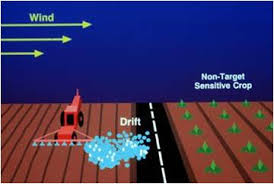 |
| http://www.canadasprayerguide.com/feature_articles/2007/fa_2007_02.php |
The training was held by a retired professor from out West. His presentation consisted of many PowerPoint presentations and pictures about proper spraying methods to reduce drift. We were given lots of handouts and literature that will be useful in assisting farmers. We learned about the different types of spray nozzles and which to use in certain situations in order to reduce spray drift. We also learned how to calibrate sprayers and viewed several demonstrations and equipment. Spray tables were brought to demonstrate different nozzles and their drift.
Drift is affected by several factors, including nozzle orifice, spray pressure and volume, angle of application, speed of tractor, and volatility of the product. Volatility, or the movement of the chemical off of the plant as a vapor, is especially important in herbicide application. Drift may cause non-target plants to be killed by the herbicide.
To reduce drift, steps can be taken before, during, and after chemical application. Before application the farmer can know where sensitive sites are, select appropriate nozzles, check and calibrate equipment, and establish buffer zones. Record keeping and a drift response plan are also important. Sensitive sites include residential areas, public roads, and schools. Droplet size changes as pressure changes. Farmers will also want to use the weather forecast to determine when and where to spray.
During spraying the farmer will want to monitor the weather, After spraying, the farmer should keep good records, including weather data. You should check the borders of the spray area to see if drift occurred, and if it did follow the drift response plan that was established.
 |
| http://ohioline.osu.edu/aex-fact/0525.html |
I enjoyed getting attending this in-service. Not only will
the information I learned be useful in my future agricultural career, but also I
know it will be helpful on my family’s farm at home. I have my private pesticide
applicator license, so I will be able to use the information from this training
for myself as well. Spray drift can be a big issue, for human safety as well as
actual success with spraying and environmental issues.
No comments:
Post a Comment